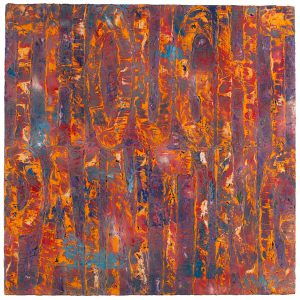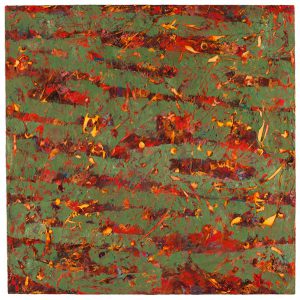Sunday
Arts and PoetryPlace Your Thoughts Here, Part I
The first of two excerpts from Shambhalian Steven Saitzyk’s new dharma art book.
by Steven Saitzyk
 Things are not difficult to make; what is difficult is putting ourselves in the state of mind to make them.
Things are not difficult to make; what is difficult is putting ourselves in the state of mind to make them.
~ Constantin Brancusi
“My creative process is a meditation.”
I have heard this statement often. While art-making and art-viewing are inherently contemplative activities, they are not the same as a meditation practice. They can parallel one another when they invoke a similar state of mind, but it is what makes them different that provides the ability for formal meditation practice to benefit the way we create and view art.
Meditation helps synchronize mind with body, right hemisphere of the brain with left, enhance intuitive and intellectual abilities, and promote clear perception. Much of art is about seeing and experiencing things as they truly are, and enjoying genuine spontaneity and unselfconscious, pure expression. Meditation helps us to better achieve this. It also dissolves creative blockages, reveals the source of creativity, and offers a path toward experiencing the sublime state in which our experience and knowledge merge into one.
Landing in the Right State of Mind
In the absence of a meditative discipline, we tend to create little rituals that we hope will lead to a starting point for our next project or recreate a state of mind to resume an existing one. We are looking for a specific state of mind, or place to land—and not just any place. Our ritual might involve making coffee, having a smoke, returning a phone call, checking email, reading the newspaper, or going for a walk or run.
Some of us clean up the work space, organize our tools, spread out our materials, trash something, or scrutinize where we left off. For others among us, stress, excitement, sex, or drugs seem to take us to the states of mind we think we should be in before we can create. Whether we are on autopilot mentally, or focused like starving vultures, we’re looking for an inner landing zone permeated with clarity and confidence. Until we are in that elusive place, we insist that we cannot begin to work meaningfully.
Whatever our personal flight plan is to get there, some of the activities we choose can end up becoming distractions, causing us to go off course or even crash land. We might get wired from drinking too much coffee, get caught up in an argumentative email, trash a project with real potential, or even become habituated or addicted. Distractions and sidetracks are limitless and our landing zones are frustratingly few. The truth is that trying too hard causes the zone to unpredictably slip out of reach or completely disappear. Nevertheless, we keep trying. The alternative is, well, there is no alternative. If there is no landing place, there is no creative process.
At this point, some among us push the envelope and fly even higher. I’ve seen many artists use exhaustion or panic as their home base for creating. With exhaustion, we dive into the distractions until they are depleted and we can only surrender. Panic involves not doing any work until it’s near impossible to meet our deadline. At that point, evasions self-destruct because we are confronted with the terror of complete failure. But these methods usually come at a high physical and emotional cost, as documented—and in some cases romanticized—in lives of artists like Caravaggio, Pollock, Rothko, and countless others.
It can be so tiring and disappointing when what we want is so simple: to come home to that place, the zone, our starting point. All we want is a place where we are alive, awake, aware, energized, and not particularly self-conscious. We are happy when we get even a taste of that and ecstatic when we’re fully there. But here’s the strange thing: when we are fully there, we most often don’t know it until we fall out of it and become self-conscious again. Our self-aware selves look back and realize we were there. We were there without self-dialoguing about it. We were immersed in the moment rather than separated from it by observing ourselves. It seems so natural when we are there and yet it can be such a challenge to get there. Why is that?
Editor’s note: To read more from Steven on this subject, see the second excerpt in tomorrow’s Shambhala Times, or check out the full text of his book Place Your Thoughts Here: Meditation for the Creative Mind, which can be found at Amazon.com.
 Steven Saitzyk is an Adjunct Professor of Humanities and Sciences at Art Center College of Design in Pasadena, and International Director of Shambhala Art, a nonprofit arts education program designed to integrate meditation into the creative process. You can read more about this work on their website: www.shambhalaart.org. Steven is also a painter, and the author of the book Place Your Thoughts Here: Meditation for the Creative Mind. Please see www.stevensaitzyk.com and www.facebook.com/placeyourthoughts/ for more about his artwork and writing. Steven is one of the founding members of the Los Angeles Shambhala Center, and has taught meditation internationally for more than forty years.
Steven Saitzyk is an Adjunct Professor of Humanities and Sciences at Art Center College of Design in Pasadena, and International Director of Shambhala Art, a nonprofit arts education program designed to integrate meditation into the creative process. You can read more about this work on their website: www.shambhalaart.org. Steven is also a painter, and the author of the book Place Your Thoughts Here: Meditation for the Creative Mind. Please see www.stevensaitzyk.com and www.facebook.com/placeyourthoughts/ for more about his artwork and writing. Steven is one of the founding members of the Los Angeles Shambhala Center, and has taught meditation internationally for more than forty years.



















Jun 17, 2016
Reply
Thank you for this, S.T.
This is so perfect to read at this creative-contemplative time, emerging from long long chrysalis/cocoon.
With great appreciation to Sara for sharing this my way today.